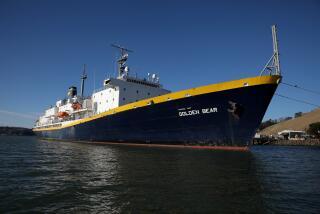First Group of Sea Marshals Ready to Protect Ships in Southland Ports
- Share via
Port officials Tuesday celebrated the first local graduating class of “sea marshals”--a new corps specially trained to prevent terrorists from turning commercial vessels and cruise liners into weapons of mass destruction.
Wearing bulletproof vests and armed with 9-millimeter Beretta pistols, collapsible batons and pepper spray, the 69 new marshals will soon begin boarding and inspecting every vessel entering and leaving the 15,000-acre Los Angeles-Long Beach port complex. They were drawn from the ranks of U.S. Coast Guard reservists and Los Angeles port police officers.
“They will do for ships what air marshals are doing for the airline industry,” said Coast Guard Rear Adm. Mary P. O’Donnell, who presented the graduation certificates during the ceremony in a Ft. MacArthur community room overlooking the nation’s largest port complex.
“Only in this case, they’ll get control of the ship’s wheel room and engine compartments,” she said, “and ensure there’s no one aboard with plans to use a chemical tanker as a battering ram or a passenger liner as a floating bomb.”
At the adjacent ports of Los Angeles and Long Beach, that task will be enormous. Each year, the ports handle more than 1 million passengers, 5,500 commercial vessels and $170 billion of commerce. In addition, more than 272 million barrels of oil are loaded and offloaded annually.
The first informal sea marshal teams were created and dispatched in the Bay Area immediately after the Sept. 11 terrorist attacks. Now, many major ports are forming them, said Coast Guard officials, who are organizing the effort.
But given the amount of traffic through the Los Angeles-Long Beach port complex, the local force is the largest of them all. It also is the only contingent to include civilian police officers.
In his address to the graduates, Mayor James K. Hahn thanked them “on behalf of the city of Los Angeles for your dedication and commitment to safety.” He noted that it is “indicative of the type of partnerships that are forming to address the new security environment arising in the aftermath of the Sept. 11 terrorist attacks.”
The 63 Coast Guard reservists were called in from their civilian jobs or schooling and joined six port police officers in the monthlong course. As sea marshals, 40 will be assigned to full-time duty for a year and 29 will serve as needed. New classes will be organized no sooner than next year, officials said.
The sea marshals’ work will be “very dangerous on a good day,” O’Donnell said.
A month ago, a Coast Guard officer preparing to step off his cutter and onto a vessel in the San Francisco Bay was seriously bruised when his leg was caught between both ships.
Port officials said the incoming interceptions will take place 24 hours a day about 10 to 20 miles at sea, in all but the most extreme weather conditions. After heading out in 87-foot Coast Guard cutters, sea marshals will make their approach toward vessels in motorized dinghies, then climb rope ladders to get on board.
While team members question the captain and crew and ensure that cargo manifests are in order, others will search for anything out of the ordinary, from unusually nervous crew members to chemical leaks. All the while, the ship will be scrutinized by the officers on board the Coast Guard cutter, and in a helicopter orbiting overhead. The marshals can also act on such non-terrorism discoveries as drugs and illegal immigrants.
Departing vessels will be similarly searched and escorted by the armed security teams on board and in boats until they are at least 10 miles out.
“It’s going to be a heck of a lot different than what I have been doing,” mused new sea marshal Elio Lombera, 22, a Coast Guard reservist who has been studying electrical engineering at the ITT Technical Institute in Sylmar. “I see it as an important duty, and an adventure.”
Standing beside her son and smiling proudly, Lombera’s mother said in Spanish, “I feel good that he’s in this program, but I’m a little scared something might happen out there.”
Graduate Eric Smith, a Coast Guard reservist who works as a police sergeant at Atascadero State Hospital, has been working informally as a sea marshal since Sept. 12.
“So far, we’ve had nothing but cooperation from every ship we’ve boarded,” he said. “In every case, we manned the bridge, secured the engine rooms, conducted a thorough search and were able to report, ‘This ship is not under duress; OK to come into port.’ ”
“We are a highly visible, effective deterrent against anyone with plans to do harm,” he said.
Capt. Manny Aschmeyer, executive director of the Marine Exchange, the agency that monitors vessel traffic in both ports, compared the situation to “people putting up with the long lines at airports.”
Ship captains and their crews, he said, have accepted recent visits by inquisitive security teams “quite graciously, almost to the point of welcoming them on board.”
“I’m really enthused about the sea marshal program; it will enhance homeland security to a great degree,” he said. “But what I really respect is the incredible sacrifice these men and women are making to serve this country and this port.”
More to Read
Sign up for Essential California
The most important California stories and recommendations in your inbox every morning.
You may occasionally receive promotional content from the Los Angeles Times.














